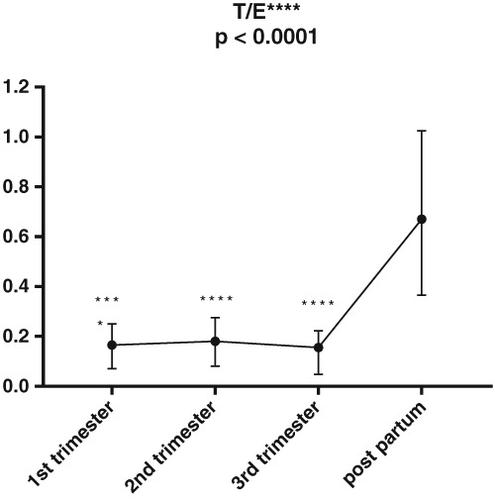当前位置:
X-MOL 学术
›
Drug Test. Anal.
›
论文详情
Our official English website, www.x-mol.net, welcomes your
feedback! (Note: you will need to create a separate account there.)
Pregnancy greatly affects the steroidal module of the Athlete Biological Passport
Drug Testing and Analysis ( IF 2.6 ) Pub Date : 2018-02-15 , DOI: 10.1002/dta.2361 Jenny Mullen 1 , Yifat Gadot 2 , Emma Eklund 3 , Alexander Andersson 4 , Jenny J Schulze 1 , Magnus Ericsson 4 , Angelica Lindén Hirschberg 3 , Anders Rane 1 , Lena Ekström 1
Drug Testing and Analysis ( IF 2.6 ) Pub Date : 2018-02-15 , DOI: 10.1002/dta.2361 Jenny Mullen 1 , Yifat Gadot 2 , Emma Eklund 3 , Alexander Andersson 4 , Jenny J Schulze 1 , Magnus Ericsson 4 , Angelica Lindén Hirschberg 3 , Anders Rane 1 , Lena Ekström 1
Affiliation

|
Concentrations of urinary steroids are measured in anti‐doping test programs to detect doping with endogenous steroids. These concentrations are combined into ratios and followed over time in the steroidal module of the Athlete Biological Passport (ABP). The most important ratio in the ABP is the testosterone/epitestosterone (T/E) ratio but this ratio is subject to intra‐individual variations, especially large in women, which complicates interpretation. In addition, there are other factors affecting T/E. Pregnancy, for example, is known to affect the urinary excretion rate of epitestosterone and hence the T/E ratio. However, the extent of this variation and how pregnancy affect other ratios has not been fully evaluated. Here we have studied the urinary steroid profile, including 19‐norandrosterone (19‐NA), in 67 pregnant women and compared to postpartum. Epitestosterone was higher and, consequently, the T/E and 5αAdiol/E ratios were lower in the pregnant women. Androsterone/etiocholanolone (A/Etio) and 5αAdiol/5βAdiol, on the other hand, were higher in the first trimester as compared to postpartum (p<0.0001 and p=0.0396, respectively). There was no difference in A/T during pregnancy or after. 19‐NA was present in 90.5% of the urine samples collected from pregnant women. In this study, we have shown that the steroid profile of the ABP is affected by pregnancy, and hence can cause atypical passport findings. These atypical findings would lead to unnecessary confirmation procedures, if the patterns of pregnancy are not recognized by the ABP management units.
中文翻译:

怀孕极大地影响运动员生物护照的类固醇模块
在反兴奋剂测试程序中测量尿类固醇的浓度,以检测内源性类固醇的兴奋剂情况。这些浓度被组合成比率,并在运动员生物护照 (ABP) 的类固醇模块中随时间变化进行跟踪。 ABP 中最重要的比率是睾酮/表睾酮 (T/E) 比率,但该比率会受到个体内部差异的影响,尤其是女性,这使得解释变得复杂。此外,还有其他因素影响T/E。例如,众所周知,怀孕会影响表睾酮的尿排泄率,从而影响 T/E 比率。然而,这种变化的程度以及怀孕如何影响其他比率尚未得到充分评估。在这里,我们研究了 67 名孕妇的尿类固醇谱,包括 19-去甲雄酮 (19-NA),并与产后进行了比较。孕妇的表睾酮较高,因此 T/E 和 5αAdiol/E 比率较低。另一方面,雄甾酮/乙胆甾酮 (A/Etio) 和 5αAdiol/5βAdiol 在妊娠前三个月高于产后(分别为 p<0.0001 和 p=0.0396)。怀孕期间或怀孕后的 A/T 没有差异。 90.5% 的孕妇尿液样本中含有 19-NA。在这项研究中,我们表明 ABP 的类固醇谱会受到怀孕的影响,因此可能导致非典型的护照检查结果。如果 ABP 管理单位不认可妊娠模式,这些非典型发现将导致不必要的确认程序。
更新日期:2018-02-15
中文翻译:

怀孕极大地影响运动员生物护照的类固醇模块
在反兴奋剂测试程序中测量尿类固醇的浓度,以检测内源性类固醇的兴奋剂情况。这些浓度被组合成比率,并在运动员生物护照 (ABP) 的类固醇模块中随时间变化进行跟踪。 ABP 中最重要的比率是睾酮/表睾酮 (T/E) 比率,但该比率会受到个体内部差异的影响,尤其是女性,这使得解释变得复杂。此外,还有其他因素影响T/E。例如,众所周知,怀孕会影响表睾酮的尿排泄率,从而影响 T/E 比率。然而,这种变化的程度以及怀孕如何影响其他比率尚未得到充分评估。在这里,我们研究了 67 名孕妇的尿类固醇谱,包括 19-去甲雄酮 (19-NA),并与产后进行了比较。孕妇的表睾酮较高,因此 T/E 和 5αAdiol/E 比率较低。另一方面,雄甾酮/乙胆甾酮 (A/Etio) 和 5αAdiol/5βAdiol 在妊娠前三个月高于产后(分别为 p<0.0001 和 p=0.0396)。怀孕期间或怀孕后的 A/T 没有差异。 90.5% 的孕妇尿液样本中含有 19-NA。在这项研究中,我们表明 ABP 的类固醇谱会受到怀孕的影响,因此可能导致非典型的护照检查结果。如果 ABP 管理单位不认可妊娠模式,这些非典型发现将导致不必要的确认程序。


















































 京公网安备 11010802027423号
京公网安备 11010802027423号